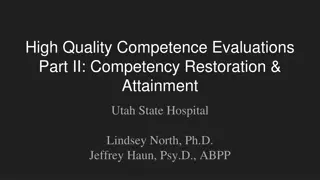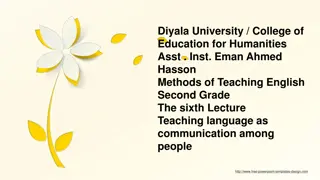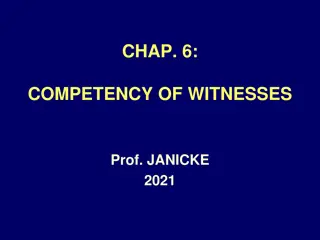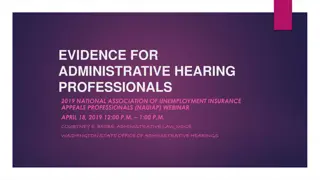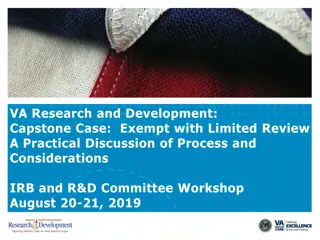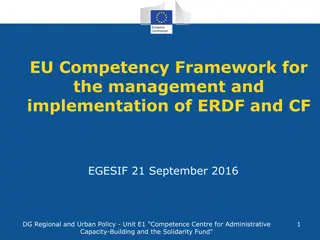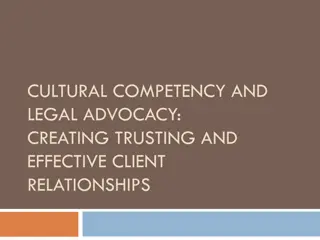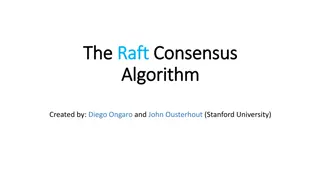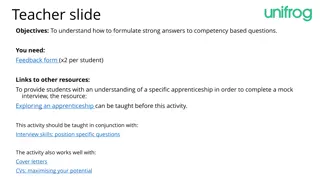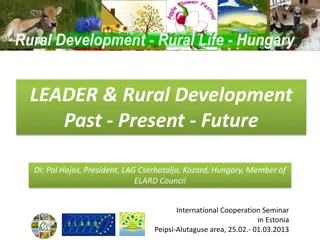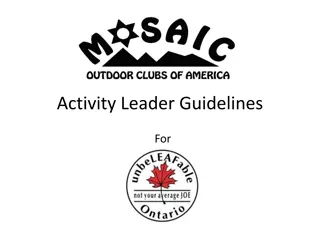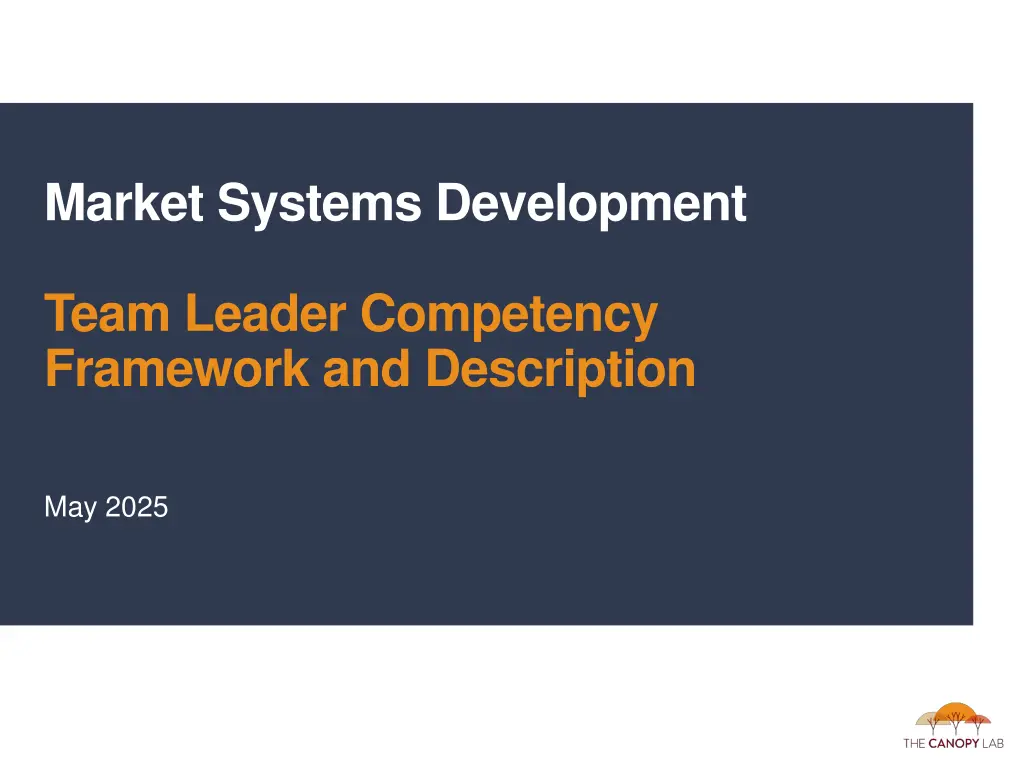
Market Systems Development Team Leader Competency Framework 2025
Explore the competencies required for successful Market Systems Development Team Leaders in 2025. Learn about managing interventions, shaping team culture, creating operational space, and more. Discover the research-backed framework and assessment tools to enhance leadership skills.
Download Presentation

Please find below an Image/Link to download the presentation.
The content on the website is provided AS IS for your information and personal use only. It may not be sold, licensed, or shared on other websites without obtaining consent from the author. If you encounter any issues during the download, it is possible that the publisher has removed the file from their server.
You are allowed to download the files provided on this website for personal or commercial use, subject to the condition that they are used lawfully. All files are the property of their respective owners.
The content on the website is provided AS IS for your information and personal use only. It may not be sold, licensed, or shared on other websites without obtaining consent from the author.
E N D
Presentation Transcript
Market Systems Development Team Leader Competency Framework and Description May 2025
Table of contents Introduction MSD Team Leader competencies I. Managing a portfolio of interventions II. Shaping the team s learning culture III. Creating the space to operate IV. Adaptive operations
What makes a successful MSD Team Leader? Since 2019, the Canopy Lab through their Inclusion & Leadership series has invested its own resources in trying to answer this critical question: what makes a successful MSD Team Leader? In 2022, the DCED s MSD Working Group commissioned research into the competencies that make successful MSD Team Leaders (TLs). Mike Klassen led this research which included surveys and interviews with more than 65 experienced MSD practitioners. This foundational work revealed four competency domains attributed to successful MSD TLs. Team Leader Competency Domains I. Managing a portfolio of interventions III. Creating the space to operate IV. Managing across functions II. Shaping the team s learning culture With the objective of supporting MSD leaders go from good to great, the Canopy Lab invested its own resources and worked closely with Mike Klassen, to elaborate upon the identified TL competencies and developed a 9-month executive coaching program. The TL competency framework and assessment tool are a result of this collaboration.
The four domains of MSD Team Leader competencies I. Managing a portfolio of interventions: deal-making, experimentation, and capacity building within a broader vision of systemic change Finding and managing good partnerships II. Shaping the team s learning culture: culture, motivation and capacity. Centering learning III. Creating the space to operate: politics, relationships and expectations. Managing pressures for fast results IV. Managing across functions: integrating HR, operations, finance and MEL. Pulling the pieces together to work cohesively
Purpose, limitations and acknowledgements What is the purpose of the Team Leader (TL) competency framework? The framework aims to provide a benchmark against which TLs and aspiring TLs can assess their own strengths and areas of improvement against the four identified competency domains. Donors and recruiters may also find the framework useful for developing ToRs and recruiting staff for senior leader roles on MSD programs. What is the research that underpins the framework? The four domains and the descriptions of the competencies were developed from 65 surveys and 10+ interviews with experienced senior leaders of MSD programs. The descriptions were then further nuanced by Mike Klassen in consultation with the Canopy Lab Managing Partners and veteran TL, Julian Peach. Feedback on the competency framework was then solicited from MSD TLs and advisors. What are the limitations? The framework and description are intended to provide a benchmark against which current and aspiring TLs can assess themselves and identify areas for further development. These tools are not intended to be used as a formal evaluation but rather provide insights on relative strengths and areas for further development. The Canopy Lab would like to thank the following market systems development (MSD) experts for their insightful feedback and constructive suggestions, which helped to strengthen this framework: Harald Bekkers, Andrew Panton, Maryam Piracha, Richard Rose, Sergio Rivas, Meseret Tefera, Ben Taylor, and John Rachkara.
Market Systems Development Team Leader Competency Framework
Overview competency domains and sub-domains DOMAINS I. Manage a portfolio of interventions III. Creating the space to operate IV. Adaptive operations II. Shaping the team s learning culture Deal-making, experimentation, and capacity building within a broader vision of systemic change Culture, motivation and capacity. Managing the most influential relationships internally and externally Making Finance, Procurement and HR more flexible and fit for MSD Creating a culture of performance and learning Managing donor relationships Finance: Strategic budget management and optimizing resources over time A Building the team s capacity to find and manage partnerships SUB-DOMAINS Technical understanding and application of MSD Creating an effective structure for technical teams Managing relationships with implementer HQ Operations/grants: Using the right instruments for the right partnerships B Developing and selling a compelling systemic change vision Encouraging open flows of information and feedback in a high-trust environment Navigating local politics Human Resources: Taking control of recruitment, promotion & performance C Connecting interventions to the systemic change vision Building bridges between MRM: and technical teams Empowering Deputy and investing in their growth D
Domain 1: Manage a portfolio of interventions Domain Sub-Domains I. Manage a portfolio of interventions: deal- making, experimentation, within a vision of systemic change. A. Building the team s capacity to find and manage partnerships B. Technical understanding and application of the MSD approach C. Developing and selling a compelling systemic change vision D. Connecting interventions to the systemic change vision
Domain 1: Manage a portfolio of interventions Sub-Domain A: Building the team s capacity to find and manage partnerships Leader behaviors Org behaviors/dynamics Leaders with this competency Organizations/programs/teams with this capacity .. Are the project s chief deal-maker, or at least one of the most proficient partnership builders at the project s early stage. They lead high-profile partner meetings and can negotiate and close deals where necessary. Quickly build and maintain a large portfolio of partners, with streamlined processes. Network heavily within focal market systems, maintaining a wide range of contacts to consistently bring new potential partnership opportunities back to the project for consideration. Coach team members on approaching and finding shared value with partners. Start and exit partnerships regularly, with support from procurement/operations. Are decisive about when to drop/exit partnerships, reinforcing the message that this is part of a bigger strategy (doesn t reflect individual/personal failure). Codify knowledge about how to develop partnerships and relationships all technical staff can point to successful partnerships they have both discovered and manage. Encourage staff to take risks and make bets - acknowledging the portfolio approach (not all bets will pay off, and that s expected). Competency Check: What does it look like? How many new partnerships are your team members bringing in? How fast can you move a potential partnership from initial discussion to agreement? Do you have the freedom to adapt initial partnership ideas to be more systemic? Does the team have an appetite for failed partnerships? What does that look like?
Domain 1: Manage a portfolio of interventions Sub-Domain B: Technical understanding and application of MSD Leader behaviors Organizational behaviors/dynamics Leaders with this competency Are comfortable with different definitions and variations of the MSD approach, familiar with their strengths and weaknesses. Organizations/programs/teams with this capacity .. Understand that MSD only 'works well' when many pieces are in place - hence the importance of investing in the project/organization to create those conditions. Can give examples of where and how MSD has been applied effectively in different contexts. Are comfortable with a range of tools/frameworks and able to adapt them to suit their needs. Can draw on tools/frameworks from inside and outside of MSD, able to communicate them to project staff in a way that's practical/relatable. Have productive, nuanced conversations about MSD, both theoretically and in the context of their work. Curate available tools/ frameworks for application in a particular project context, and understand where there are gaps. Competency Check: What does it look like? Are the Team Leader and staff comfortable talking about MSD using their own language? How do they introduce / define MS to colleagues, staff and donors? Do team members use key terms like crowding in correctly and consistently? If they were to run an introductory MSD training for the team, what would they emphasize? Do team discussions explore relevant systemic dynamics and the systemic dimensions of the project s work, avoiding dead-end conversations about whether something is MSD or not?
Domain 1: Manage a portfolio of interventions Sub-Domain C: Developing and selling a compelling systemic change vision Leader behaviors Organizational behaviors/dynamics Leaders with this competency Organizations/programs/teams with this capacity .. Develop and cultivate a shared vision of what the team is trying to achieve in the market system (e.g. facilitating collaborative workshops). Invest in structural (but limited) analysis and synthesis to identify underlying causes and patterns Have understanding and buy-in to the vision for market system change Constantly sell the vision to the team, to partners, to donor, etc. Finding different ways to articulate, visualize and explain the core changes. Conduct regular sensemaking sessions: share ideas, information and seek mutual feedback Analyze whether a strategy is likely to lead to sustainable behavior change and transformational system change. Access primary sources of information to continuously learn about the market, check initial estimates and information, triangulate opinions. Emphasize experiment as the means for achieving systemic change in market systems, building a process of experiment into the way interventions are designed and managed. Competency Check: What does it look like? Does a succinct vision for system change exist? Is it tacit? Written? Visual? Is the team bought into the vision? Do they understand the vision? Is it translated into their particular roles/sectors? Does your vision for market system change consider the diversity of people in the market system and their different relations to that system? Can the team (and their designs) show a steady process of tactical and strategic adaptation?
Domain 1: Manage a portfolio of interventions Sub-Domain D: Connecting interventions to the systemic change Vision Leader behaviours Org behaviors/dynamics Leaders with this competency Organizations/programs/teams with this capacity .. Keep the full spectrum of activities in mind and how they interact and how the learning from the interventions and their synergies are moving the market systems forward (stimulating change) Identify intervention synergies and team members start to coordinate directly Internalize the vision and can articulate it in relation to their specific work/interventions Help staff remember the system perspective by reinforcing the bigger picture vision (scale and sustainability). Work through implications for staff in their individual work. Are willing to drop/adjust interventions that aren t leading to desired systemic changes Encourage strategic decisions about the overall portfolio and its likely influence on system. Include each other in meetings with partners (and managers join too - to role model) Competency Check: What does it look like? Does the TL tailor or translate the system change vision into work on particular sectors/interventions? How much time does it take to build systemic impact into new partnerships? Does the team jointly examine/question/explore their vision (or map) of the system? Do decisions about whether to add/drop/expand partners and interventions get made? And, to what extent are they linked to the wider view/vision of the system?
Domain 2: Shaping the teams learning culture Domain Sub-Domains A. Creating a culture of performance and learning B. Creating an effective structure for technical teams C. Encouraging open flows of information and feedback in a high- trust environment D. Building bridges between MEL and technical teams II. Shaping the team s learning culture: Culture, motivation and capacity.
Domain 2: Shaping the teams learning culture CULTURE Sub-Domain A: Creating a culture of performance and learning Leader behaviors Org behaviors/dynamics Leaders with this competency Define a desired culture of performance based on learning and critical thinking. Act as a role model this by asking questions, seeking feedback and debating. Organizations/programs/teams with this capacity .. Have a performance system that prioritizes learning, sharing failures, and risk taking by staff Promote a positive team culture across the program - ownership, initiative, curiosity, action, inclusiveness, high- quality delivery, fun Communicate clear performance expectations for staff: Create trajectories for staff who demonstrate an interest in learning and improving, and not retaining those who do not. Uses visual cues in the office to encourage team members to engage with and iterate program and intervention logic (e.g. posters of system changes) Encourage, reward and act as a role model on coaching and mentoring among team: spend time 1-on-1 working through strategic and tactical issues with team members. Enable promotions to management positions for project staff Encourage team members to be proactive, creative and adopt problem-solving mindset: come to me with your proposed solution, not your problem. Empower project staff to speak up, take initiative and be creative Encourage collective improvisation - integrated interventions across teams/portfolios What does it look like? Prompts for reflection and discussion Is the Team Leader seen as the best/only expert or does (s)he enable the team to provide their expertise or insights as well? Is there a culture of active learning such as attending webinars, exchanging documents and comments, giving ideas and encouragement to each other? Does the project provide appropriate training and coaching for team members? Does the project leadership join intervention managers for market research or partner meetings to help and empower the latter to make decisions, rather than to just supervise?
Domain 2: Shaping the teams learning culture CULTURE Sub-Domain B: Creating an effective structure for technical/sector teams Leader behaviours Org behaviors/dynamics Leaders with this competency Organizations/programs/teams with this capacity .. Technical leaders feel ownership and autonomy of their domain - with a strong desire to learn, test and experiment. Have a clear vision and strategy for translating the project s objectives into a set of technical teams with autonomy and interdependence. Technical teams have an appropriate balance of knowledge/expertise of specific sectors vs. MSD approach, process Design a realistic team structure based on budget and available talent. Decide which skills/expertise need to be in-house vs. which can be outsourced. Technical teams coordinate with each other to co-design and align interventions, identify synergies Adjust and restructure technical team structure based on strategic learning and team dynamics Communicative, supportive relationship between the project team and implementer s headquarters. Give the team confidence to go in a direction, space for learning, as well as guidance and course correction. What does it look like? Prompts for reflection and discussion Is there adequate knowledge and use of MSD, GESI, MRM and sector-specific expertise across the technical teams? Do technical teams draw on the expertise of GESI and MRM specialists to help design, deliver and monitor effective interventions? Do the different teams/individuals meet and talk to each other regularly, without the initiative needing to come from the Team Leader? Do team members think of themselves as facilitators? Do they act like they are? Is anyone impractically overworked? Does each team member have the chance to substantively engage with every partnership?
Domain 2: Shaping the teams learning culture Sub-Domain C: Encouraging open flows of information and feedback in a high-trust environment Leader behaviors Org behaviors/dynamics Leaders with this competency Organizations/programs/teams with this capacity .. Build trusting relationships with team members based on curiosity, active listening and empathy. Have a culture of trust, strong team relationships and openness to failing and learning - a safe space for the team to interact. Act as role models for openness and vulnerability - not having all the answers, relying on team members to step up. Signaling that you will make mistakes. Encourage team members to share unfinished work (partial solutions, unfinished analysis ) and constantly seek feedback and new information. Reward and incentivize information sharing and learning - within teams, across teams. Ask tough questions and give feedback; generate creative ideas in group discussions. Understand the culture and politics of the society, and helps the team look critically at how society functions. Promote a culture of learning and enquiry, rather than (assumed) expertise. Manage conflict productively: identify and intervene in difficult issues; resolve clashes between project team members. Make mistakes, highlight them, and ask for help to correct them demonstrate intellectual honesty. What does it look like? Prompts for reflection and discussion Do team members regularly (and fearlessly) ask questions, in and out of meetings? During team meetings, are most contributions from team members assertions or questions? Are assertions challenged or taken at face value? Do the Team Leader and project component managers encourage and support team members to be open and collaborative with their colleagues? How willing are team members to make mistakes?
Domain 2: Shaping the teams learning culture Sub-domain D: Building bridges between MEL teams and technical teams Org behaviors/dynamics Leader behaviors Leaders with this competency Create a framework for making decisions, coordinating between interventions, and reviewing progress Organizations/programs/teams with this capacity .. The MEL/MRM lead is member of leadership team - key to driving insights and gathering feedback Position the MEL/MRM team as a source of learning and information that should influence decisions and course- correction. Learning is seen as part of technical team s responsibility - not just a separate function Collective reflection and decision-making during strategic review exercises - everyone participates with curiosity and critical inputs Help technical teams articulate results chains and theory of change, linking their work to broader vision Prioritize and emphasize importance of project-wide learning and strategic review exercises Collectively review progress drawing on best available information to course correct What does it look like? Prompts for reflection and discussion Does the project team demonstrate curiosity and collect ad hoc data when needed ( let s go figure that out )? Is there a clear definition and alignment of roles between MEL/MRM and intervention managers? (e.g. Intervention staff lead on measurement, advised and enabled occasionally by MRM colleagues; MRM lead on aggregation and projections at project-level). Is there clear evidence of continuous monitoring, learning and adaptation to interventions? (e.g. MRM plans completed in detail for the next 12 months and in less detail after that; changes made to intervention guides every 12 months or more regularly)
Domain 3: Creating the space to operate: politics, relationships and expectations Domain Sub-Domains III. Creating the space to operate: Politics, relationships and expectations. A. Managing donor relationships B. Managing relationships with implementer HQ C. Navigating local politics D. Empowering deputy and investing in their growth
Domain 3: Creating the space to operate Sub-Domain A: Managing donor relationships Leader behaviours Org behaviors/dynamics Leaders with this competency Organizations/programs/teams with this capacity .. Understand what the donor needs to see from your project for license to continue operating, and provide it An environment of trust between donor and program team. Donor participates in key learning conversations as a thought partner, helping to explore and address difficult challenges. Explain MSD in compelling terms that are consistent w/ donor needs Donor capacity for understanding MSD grows over time- through training, constant messaging, and experience/following the program s own learning. Communicate long-term vision for change Communicate process of learning and capacity growth of team during early years where there are less visible results. Know when to invite donor into learning processes and staff capacity trainings. Communicate deviations from design with strong rationale/evidence for why changes were made. What does it look like? Self-assessment questions Do the team leader and donor representative have frequent, formal and informal exchange in person and by phone? Does the donor representative participate in discussions as a thought partner, or as a client expecting to have their interests served? How honest, open and realistic are conversations between the team leader and donor representative? Does the project support the funder s representative with communications that explain the project approach and its progress, helping the representative satisfy their own requirements for showing progress?
Domain 3: Creating the space to operate Sub-Domain B: Managing relationships with the implementer HQ Leader behaviours Org behaviors/dynamics Leaders with this competency Organizations/programs/teams with this capacity .. Identify key blockers/resisters and work to bring them onside Communicate the project s learning within the organization Work with key org leaders/allies (outside the project) who trust/support you Manage HQ expectations - in terms of analysis, results, procurement timelines Work with HQ-based project leaders/allies who trust/support you Negotiate with organizational leadership to make the case for shifts in organizational systems (to be more adaptable/suitable to MSD programming) Can rely on HQ-based staff to help them navigate requests and other communications from HQ What does it look like? Self-assessment questions How would they describe the relationship between the project and HQ support staff? Is it supportive or policing? Enabling or auditing? Is it focused on helping the project perform or focused on helping avoid risks to the parent organization? Are regular meetings online between project leadership and HQ staff to discuss project progress, contract deliverables supportive or accountability-focused? (i.e., more like problem-solving or more like reporting?) Does the Team Leader/ project conduct on-boarding of new-comers both allies/ potential blockers to orient them/ manage expectations/ overcome resistance towards the project and MSD approach?
Domain 3: Creating the space to operate Sub-Domain C: Navigating local politics Leader behaviours Org behaviors/dynamics Leaders with this competency Organizations/programs/teams with this capacity .. Have frequent formal and informal interactions with local leaders Invest in political economy analysis and be purposeful with how you deploy that understanding Understand local politics/politicians and what they are expecting from your project (explain what they want from you) Through sensemaking with team members, build a Politics machine the capacity to understand the local political interests in a given situation (good advice; confidentiality; impartiality/arms-length) Prioritize local political knowledge/networks during hiring to ensure team has adequate political capital and networks (how to check on reproducing existing elites in who/how you hire) Appreciating that the public space and politics is part of MSD approach; projects cannot avoid the public space. Use PEA effectively /intelligently to navigate local politics, pushing transformative work without engendering too much resistance from entrenched interests Understanding civil society s role in the political aspects of how markets work and change. What does it look like? Self-assessment questions What staff relationships and capacities inform the project s understanding of local politics? Do intervention staff include power in the market system analysis and its representation in formal political and informal traditional institutions? Does the project understand local political interests as they relate to project activities? (e.g., is the brother of a local councilman responsible for the purposeful mismanagement of the water systems the project is trying to improve?) Are any project staff too close to local leaders, providing biased advice or funneling sensitive information to them?
Domain 3: Creating the Space to Operate Sub-Domain D: Empower deputy and invest in their growth Leader behaviours Org behaviors/dynamics Leaders with this competency Share power, delegate management responsibility to a deputy Organizations/programs/teams with this capacity .. Deputy is highly trusted/respected by overall program team, and seen as a safe venue for providing feedback to TL (if not directly) Share honest reflections, receive feedback on their performance as TL Deputy role models giving public feedback to the TL - signaling to the team this is appropriate/welcomed Empower deputy to support teams, help with decision making and grow their skills as a leader Recognize the comparative strengths of a deputy and are willing to defer to deputy in situations where deputy has more expertise/knowledge What does it look like? Self-assessment questions How well informed is your mentorship work with your deputy? Are you helping them succeed in their role, based on an understanding of their capacities and interests? How much of the technical leadership responsibility has been delegated to the deputy? Does that support a reasonable workload for the TL and the deputy? Same question for operational responsibility? Does the deputy model leadership behaviors around openness to questioning and fairness?
Domain 4: Adaptive Operations Domain Sub-Domains A. Finance: Strategically managing the budget, optimizing resources over time Operations/Grants: Using the right instruments for the right partnerships Human Resources: Taking control of recruitment, promotion and performance V. Adaptive operations: Making Finance, Procurement and HR more flexible and fit for MSD B. C.
Domain 4: Adaptive operations Sub-Domain A: Finance: Strategically managing the budget and optimizing resources over time Leader behaviours Org behaviors/dynamics Leaders with this competency Organizations/programs/teams with this capacity .. Demonstrate financial management skills in an MSD context: understanding fixed vs. operating costs, fluctuations of intervention costs over time, prioritization of salaries for key positions Robust system for dealing with unpredictable expenditures and communicating with donor Streamlined processes for basic functions (timesheets, expenses, payment requests) Coach finance leaders to understand MSD strategy and its budget implications Project teams understand their budgets without being overly focused on spending exactly as projected Engage technical teams in developing budgets, build their capacity to forecast & track spending Align operational and business administration systems, including across consortium partners What does it look like? Self-assessment questions What is the pressure to spend on your project? How often and in what contexts does the project s burn rate come into conversation? How regularly and in what forums are your technical teams involved in conversation about the budget for their work? How much of the overall project budget are you spending this year? Have you put money into play early enough to lower anxieties about burn rate and to have a chance to discover opportunities? Are you managing the spend forecast for future years while also accounting for spend and annual budget? How easily can you move budget items between categories to enable adaptive management?
Domain 4: Adaptive operations Sub-Domain B: Grants & Procurement: Using the right instruments for the right partnerships Leader behaviours Org behaviors/dynamics Leaders with this competency Organizations/programs/teams with this capacity .. Understand operations and procurement rules and processes. Operations is positioned as part of senior management team Assess the risk appetite of the donor manager and HQ project manager/oversight Operations understand technical strategies and are consulted on instruments/mechanisms for different partnerships. Influence HQ teams and donor counterparts to gain approvals/permission to adapt internal procedures to MSD project An entrepreneurial approach to procurement, grounded in understanding of rules of the donor. Implement risk mitigation strategies that satisfy donor and implementer risks. Coach grants and procurement staff to understand MSD strategy and why partnerships may be managed differently than other projects What does it look like? Self-assessment questions What is your current approval process for partnerships/grants: who is responsible for approving what? Where are the main bottlenecks? What proportion of partnerships are getting quickly approved? What proportion get stuck in lengthy delays and multiple rounds of review? Do you have a proactive, competent, solutions-oriented operations team that is bought into MSD strategy and actively helping problem-solve compliance issues? How easily are partnership agreements amended/adjusted/improved?
Domain 4: Adaptive operations Sub-Domain C: Human Resources: Taking control of recruitment, promotion and performance Leader behaviours Org behaviors/dynamics Leaders with this competency Generate buy-in and support from HR staff to the MSD vision and its personnel requirements Organizations/programs/teams with this capacity .. Competency-focused hiring strategies Creative recruitment strategies for new staff Adapt standard recruitment processes to attract team members with the right skills and mindset Flexible pay to attract and retain the right people Adapt performance review processes to prioritize learning & creativity, rewarding strong contributors. On-boarding processes for new-comers are comprehensive and designed to quickly and effectively integrate them into the team culture Provide feedback and link staff to new opportunities (tasks, placements, trainings, mentoring) Poor performers are phased out and high performers rewarded through remuneration and professional development Value all people equally - no favorites. What does it look like? Self-assessment questions Does your hiring process provide you access to quality personnel with a variety of relevant experiences (not just development sector)? To what extent are all key technical personnel hired based on MSD competencies? Are your performance review processes dynamic, engaging and focused on a balance of (a) results, (b) learning and (c) career development? Are there realistic prospects for people to get promoted to leadership positions within the project? Does the wider organization create pathways and opportunities for people beyond the project?




